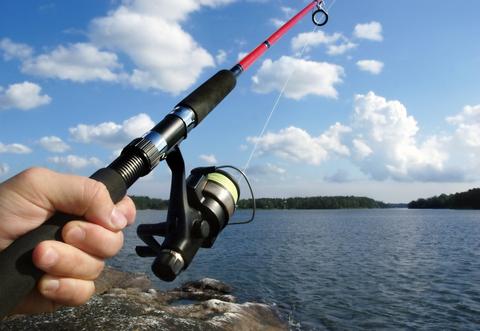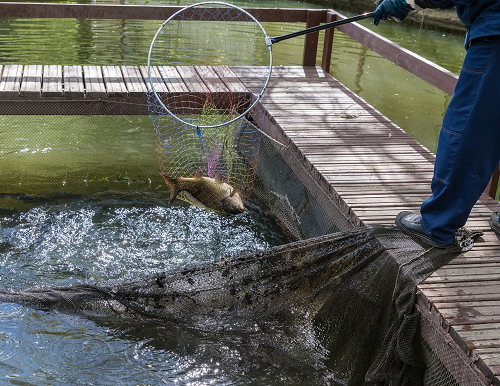

Everyone loves to see a villain in handcuffs. That’s why fishing tournaments targeting invasive species remain so popular. And apparently, invasive carp are the new northern snakehead. (Unfortunately, while snakehead are easy to clean and eat, carp have small intramuscular bones that make them less desirable).
Invasive carp (an umbrella classification that includes bighead carp, silver carp, black carp and grass carp) are a widespread problem. According to the Great Lakes Fisheries Commission, the fish can be up to (and sometimes bigger than) 100 pounds and four feet in length.
That, of course, makes them incredibly popular as a gamefish – their lack of edibility notwithstanding. And nationwide, tournaments are springing up to help catch the bad guys.
One of the more popular is the annual Redneck Fishing Tournament in Bath, Illinois. Costumes, helmets and boat decorations are encouraged – and seem to be as much a part of the fun as the fishing itself.
According to the Journal Star, “The event began more than a decade ago to battle the carp invasion of the Illinois River, which runs alongside Bath. The fish, which overwhelm natural ecosystems, jump out of the water when startled by passing boats.”
Oh, and don’t worry about bait; the tournament doesn’t use poles. In fact, carp are simply netted out (yes, there are that many) – or jump into the boats. (Yes, they jump in. Yes, really).
The newspaper notes, “Past winners have caught hundreds of these fish in just two hours. The fish are later buried along the riverbank.”
The tournament is a festival-style event, with bands, a beer garden, raffles and food vendors, with the proceeds going to veterans organizations.
And they do get those fish. According to one travel blogger, organizer Betty DeFord noted, “Total fish count for Redneck 2021 first day total: 1608, second day total: 1226.”
Another tournament, Carp Madness, sponsored by the Kentucky Department of Fish and Wildlife, and held on Kentucky Lake, brought in 40 tons of carp. And unfortunately, say officials, it’s just a drop in the proverbial bucket.
Carp are not only invasive, they crowd out the local species. In fact, even venerable Lake Chickamauga in Dayton, Tennessee, the host of top-level bass tournaments, has seen an infiltration. (The first evidence was found when an angler engaged the motor on his boat – and a fish jumped in. After a flurry of phone calls, social media posts and e-mails, the fish was identified; the angler noted he saw plenty of others in the lake).
So how do the fish get there? It was theorized that the one found in Lake Chick swam up the Tennessee River, a feat that included going through navigation locks, U.S. Fish and Wildlife officials said.
It is theorized that fish have been introduced throughout the U.S. in multiple ways. The National Park Service says these include:
Intentional Introductions
- Releasing unwanted aquarium fish into a lake. (That’s how the northern snakehead wound up in Maryland – and plenty of other places – an aquarium hobbyist was keeping them but released them into a local pond in honor of a family member who had been ill; Mother Nature took it from there). Similar problems are being seen with those who release goldfish into the wild. In fact, The Guardian notes, in 2013, a report in Scientific American stated that researchers trawling Lake Tahoe netted a goldfish that was nearly 1.5ft long and weighed 4.2lb. The author of a report on California’s aquarium trade said: “Globally, the aquarium trade has contributed a third of the world’s worst aquatic and invasive species.” In Minnesota, officials in Carver County removed upwards of 100,000 goldfish from local waters in the last two years alone. (Worth noting: Goldfish are a species of carp and can survive as well and breed just as quickly as their counterparts mentioned here).
- Stocking sport fish outside their native range.
- Liberating unused bait fish.
- Introducing non-native species for management (bio-control, ecosystem engineering). And that’s what happened with carp: According to the Invasive Carp Regional Coordinating Committee, the fish were originally imported from Southeast Asia (in fact, they are still in some places known as Asian carp) to the southern United States to help aquaculture and wastewater treatment facilities keep retention ponds clean. Flooding and accidental releases allowed carp to make their escape and migrate into the Missouri and Illinois rivers, as well as the Mississippi River. And while biologists thought the fish were sterile, nature proved them wrong.
Unintentional Introductions
- Trailered boats.
- Ballast water discharge.
- Escape of organisms from hatcheries and aquaculture facilities
- Herons and other predators flying between ponds and unknowingly carrying fish eggs on their feet and legs
And while the issue of fish jumping into anglers’ boats may sound like a dream come true (or like something out of a sit-com), the reality is more serious.
“A jumping carp that collides with a passenger in a moving boat can cause serious injury,” notes the agency. “This scenario is most common in shallower waters and boaters should slowly retreat from areas with jumping carp to avoid impact.”
But, Trout Unlimited points out, invasive carp can affect not just the ecological balance of a waterway but the livelihood of everything they touch. For example, the Great Lakes are an economic engine for the nation. Their commercial, recreational and tribal fisheries alone are valued at more than $7 billion per year and support more than 75,000 American jobs. And carp stand to disrupt that substantially.
According to Western Bass, biologists expect that if these invasive carp make it to Michigan waters, the fish will disrupt the food chain that supports native fish of the Great Lakes, such as walleye, yellow perch and lake whitefish – which could diminish fishing opportunities for sport and commercial anglers – and that includes the tournament circuit.
Fisheries are taking action above and beyond tournaments. Some are (don’t miss the video) electrocuting the fish and then netting them out. Others are hosting contests with a Shark Tank (carp tank?) format, challenging people to develop ways to keep the fish out, with significant monetary prizes.
Anglers are quick to note that the invasive carp, in all four of its forms, should not be confused with the common carp, a favored target of fly fishermen. While common carp are, in some cases, considered a nuisance species, they are not as problematic as the invasive carp, says Western Bass.

